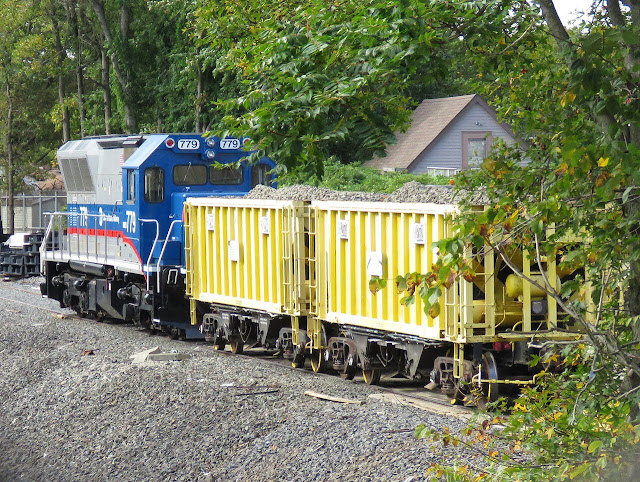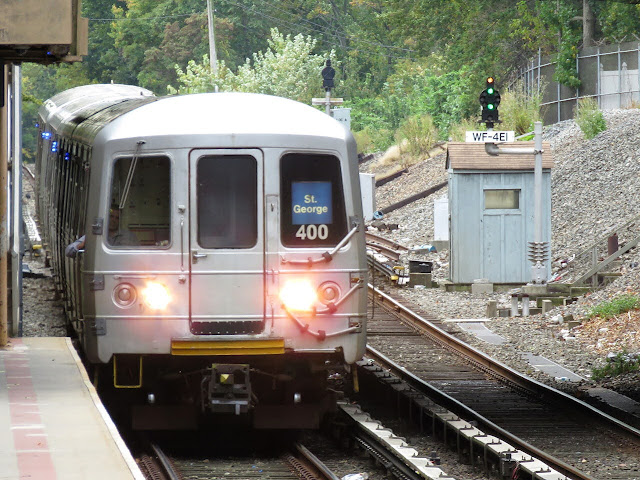The Staten Island Railway is an odd duck to say the least. Ostensibly still an FRA railroad, it is run more like a transit system with no connection to the national network and a variety of FRA waivers. While the equipment consists of NYCTA St. Louis Car R44's, the line is equipped with Baltimore and Ohio Color Position Lights and cab signals? This strange situation has its roots stretching back to the 19th century, but today most of my interest is centered on the B&O CPL based signaling system and to a lesser degree, the R44s. I have ridden the SIR on two other occasions, the first in 2000 when I only had a film camera, the second in 2004 when I went over to see what was up with the re-signaling project. A required secondary trip for the SIR is the related Staten Island Ferry to be prepared for the requisite photos of the Statue of Liberty and downtown when you check out the full set of photos here (mirror). In addition I went out to get pictures of remaining classic interlocking towers on the IND Fulton St line.
Kicking things off south of Baltimore early in the AM, the brutalist BWI Airport Rail Station has been rebuilt as a coffee shoppe.
Taking photos of the defunct Central Railroad of New Jersey Communipaw terminal is perhaps the one rail related thing one can do on the Staten Island Ferry.
The free Staten Island Ferry is the most affordable way to get photos of the Statue of Liberty and Lower Manhattan.
Most of the 10 tracks at the St George ferry terminal are used for mid-day car storage. The 61 R44 cars, built by St. Louis Car in 1973, make up the entirety of the fleet. #400 shown here, is not the class leader as their numbering starts with #388.
The 290 NYCTA cars were retired in 2010 due to a surprise discovery of frame cracks and corrosion. With a lighter duty schedule and different maintenance regime the SIR cars were not affected and are now approaching their 50th year in service. Here numbers 392, 450 and 446 can be seen at the railroad east end of the station platform waiting their next call to service.
TOWER B was constructed by the B&O around 1952 and housed a GRS N-X type interlocking panel to control the St. George terminal and eventually the other end of the line in Tottenville. Although the 2004 CTC project consolidated dispatching functions in a new TOWER A built on the other side of the terminal, the terminal interlocking logic inside the original tower was not replaced and TOWER B still serves as a alternate control center with a replacement panel interface.
Since forward views from the SIR cars are limited to a peephole, frequently blocked by the crews, I didn't have much to do until I arrived at my destination of Huguenot. Here we can see #400 passing by the eastbound signal at WOLF interlocking, approaching the signal at POND interlocking displaying a Clear signal indication.
Wayside CPL signals on the SIR are located only at interlockings with intermediate signaling being handled by a new pulse code based cab signal system similar to the type used on main line railroads. The cab signals and intermediate interlockings were installed as part of the 2004 CTC project. Prior to that the line has used hand throw switches and temporary block-stations to conduct single track operations.
The stations were never set up for fare control with conductors collecting tickets until turnstyles were installed at St George and, later, Thompkisville. As the vast majority of passenger traffic connects to the SIF there was little revenue loss making the rest of the line a fare free zone. Therefore there is no need for the slate roofed ticket office to be open to the public.
The SIR MoW fleet consists of 4 BL20G road switches purchased in conjunction with Metro North's order of 12 passenger capable BL20GHs. This replaced a pair of elderly Alco switchers that was subsequently donated to museums. I caught #779 attached to some ballast hoppers on the MoW siding at Huguenot.
The mid-day headways were terrible, which prevented me from visiting other stations as each stop would have resulted in a minimum 30 minute time penalty. Also, MoW work was causing some service disruptions and mu westbound trainset arrived before the following eastbound, depriving me of a photo op. With 30 minute headways I suspect the SIR was only running two trainsets and #400 showed up adjacent to a Clear signal at WOLD interlocking for the tardy eastbound.
The source of the delays was some MoW work at Thompkinsville, where some strange single tracking was going on. Despite the 30 minute headways, the schedule was not adjusted to prevent inbound and outbound trains meeting within the single track area. Here my train departs Thompkinsville under an Approach Proceed Cab signal indication on the VICTORY interlocking 10W signal just before SIR BL20G #776 runs through the station in preparation to enter the Thompkinsville siding from the east end.
An eastbound train then advanced forward on the westbound track led by SIR #444.
As BL20G #776 was moving westward through HANNAH interlocking, the eastbound SIR local received a Clear signal on the HANNAH 2W signal and continued to wrong rail to the next crossover.
#776 then advanced into the Thompkinsville siding to couple up to some flatcars.
The MoW train when shoved ahead past a slow approach signal and onto the main. If you are interested in the intricacies of SIR signaling you can see my Position Light post here.
My SIR tour complete, I got lunch in St. George and proceeded back to the SIF. The SIF has an interesting railroad connection in that all the boats are powered by diesel engines built by EMD. For example the Andrew J. Barberi, shown below, has 3 16 cylinder 645E's.
The new SIF Whitehall terminal provides direct connections to the 1/9 and N/R subway stations.
R train with NYCTA R46 #5834 at Jay St.
A train with NYCTA R46 #6054 at Hoyt.
Active interlocking tower at Hoyt St with its original GRS Model 5 pistol grip interlocking machine.
Although the tower at Utica Ave is still active, it is not normally staffed unless there is a need to cross over trains due to track work or other disruption. The Model 5 pistol grip interlocking machine can be seen in the center of the room. Green lights on the model board indicate track occupancy. Blue lights indicate track occupancy within the length of a station platform.
R46 A train at Utica Ave.
The tower at Broadway Jct is set back from the end of the platform and lacks direct view windows so here is a photo of an A train with R46 #6234 at Dr. Van Nostrand Ave.
My goal was to visit the tower at Lafayette, which necessitated changing to a C train local at Nostrand. I lucked out and was presented with a set of R32's including #3411 shown here.
A Train of R46's passing through Lafayette on the central express tracks.
My luck would end there as I had forgotten that, for some inexplicable reason, Lafayette did not have a Mezzanine and since I was both up against the clock and already had pictures of Lafayette, I decided just to abort instead of riding to Hoyt (1 headway), riding back to Lafayette (1 headway), continuing to Utita (1 headway) and then finally resuming my trip downtown (1 headway). Time constraints was also why I just caught an R160 C trainset instead of waiting for the next train of R32s.
The ticking clock was due to my need to catch a certain outbound express train at Grand Central, which I arrived to find waiting on one of the upper lever 30 series tracks adjacent to P32AC-DM #209. End cars on my train of M7's were #4164, #4159.
From there I would travel to my overnight destination from where I would
embark upon a driving/walking tour of Metro North Drawbridges (sounds
exciting, right?).
From there I would travel to my overnight destination from where I would
embark upon a driving/walking tour of Metro North Drawbridges (sounds
exciting, right?).

































No comments:
Post a Comment